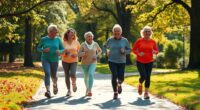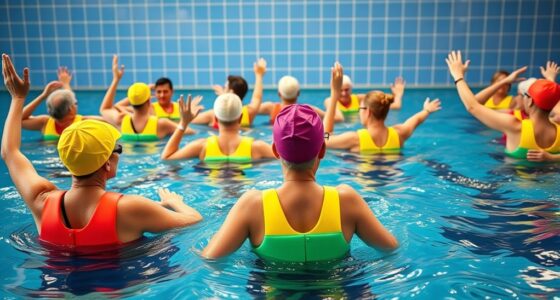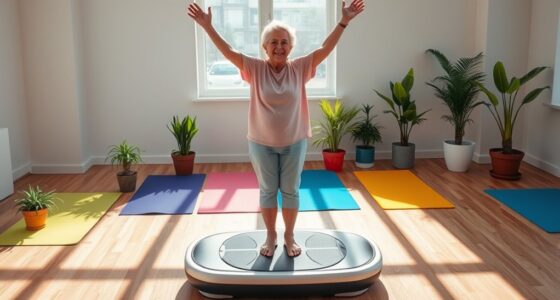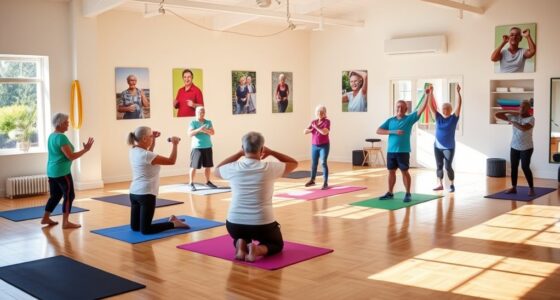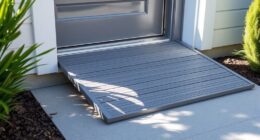If you’re looking for a way to strengthen your core easily, Senior Pilates is a fantastic option. It focuses on building core strength through gentle, effective floor exercises tailored for your needs. You’ll enhance your balance, boost functional strength, and even reduce back pain. Plus, the mindful practice helps you connect with your body as you move. Stick with it, and you’ll discover even more benefits and techniques to enrich your Pilates experience.
Key Takeaways
- Engage your core by pulling your belly button into your spine during exercises for better alignment and stability.
- Incorporate gentle movements like glute bridges and pelvic tilts to strengthen the core and glutes safely.
- Use modifications and alternative movements to accommodate varying fitness levels and ensure safe engagement.
- Practice mindfulness techniques to enhance focus and connection to your body throughout the session.
- Create a comfortable, distraction-free environment to promote relaxation and improve your Pilates experience.
Understanding Mat Core Pilates for Seniors
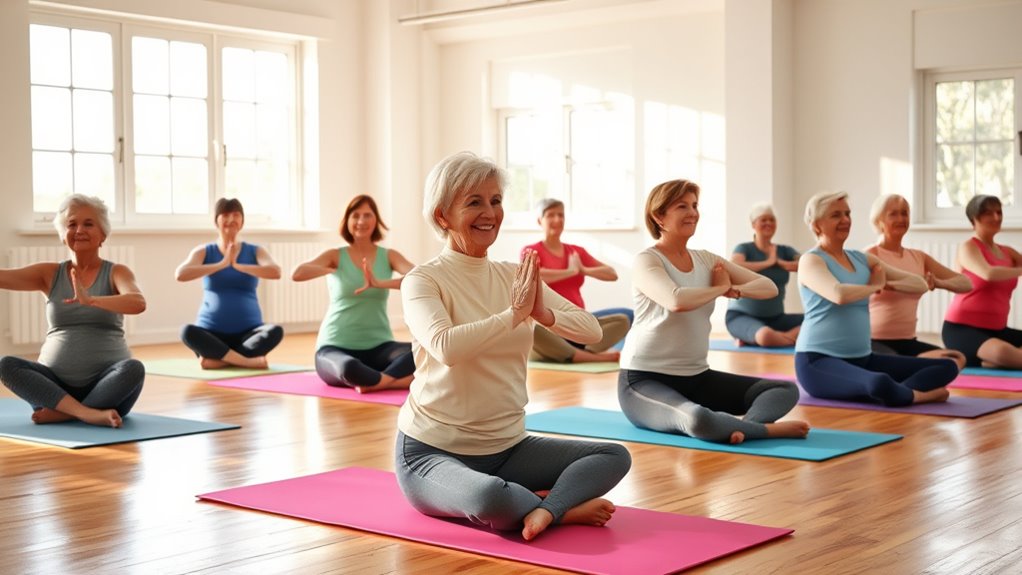
When you engage in mat core Pilates for seniors, you’ll find that it focuses on building core strength through a series of effective floor-based exercises.
You can start small, gradually increasing repetitions and sets to develop endurance safely. The exercises target your glutes, pelvic region, and overall core stability, helping you feel nice and tall. Incorporating grounding techniques can also enhance your focus during these movements, allowing for a more centered practice. Practicing mindfulness can further improve your decision-making during your exercises, leading to better form and engagement. Engaging in these exercises can also promote cognitive development, as they stimulate brain activity through focused movements.
It’s essential to check your form throughout each movement, ensuring you’re aligned and engaging the right muscles. Don’t worry if you have limited mobility; modifications are available to suit your needs, allowing you to participate without straining yourself.
Incorporating deep breathing techniques also enhances muscle engagement, making each session both effective and enjoyable. Additionally, engaging in these exercises can greatly contribute to enhancing your overall senior well-being, as they promote both physical and mental health.
With consistency, you’ll notice improvements in flexibility and overall wellness.
Benefits of Core Strengthening
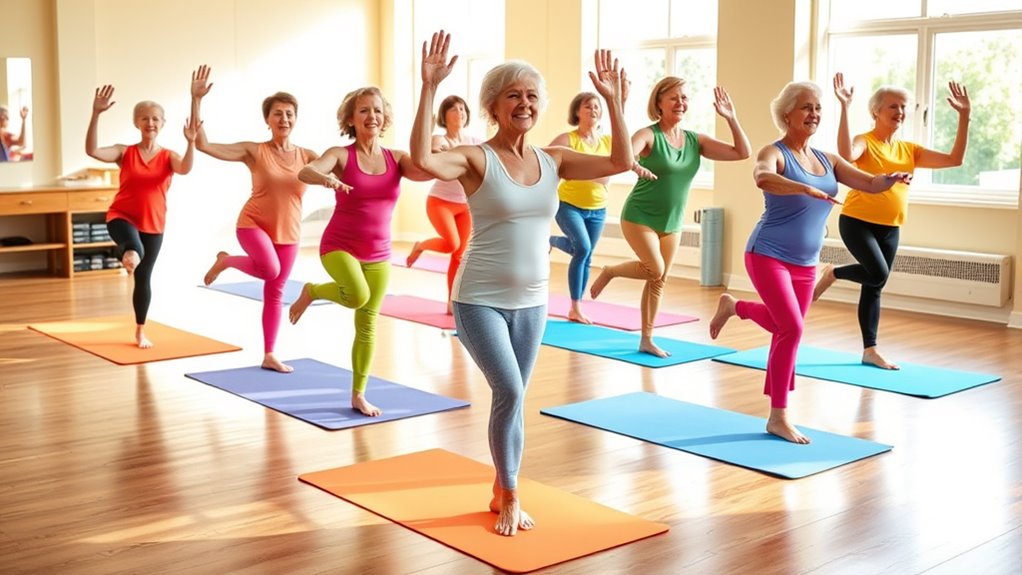
Building on the foundation of mat core Pilates, core strengthening offers numerous benefits that are particularly valuable for seniors. Here are some key advantages you can enjoy:
- Enhanced balance and stability to help prevent falls and improve your mobility. Engaging in core exercises can significantly reduce the risk of falls, which is a major concern for the elderly. Regular exercise can also contribute to cognitive decline prevention, allowing for a more active lifestyle. Additionally, maintaining physical activity can improve emotional well-being in older adults, fostering a positive mindset. Strengthening your core can also support spinal health by promoting better alignment and stability.
- Increased functional strength, making everyday tasks like lifting or bending easier and safer.
- Reduced risk of back pain by supporting your spine and addressing age-related changes in spinal health.
- Improved posture that aligns your body better, alleviating discomfort as you age.
Engaging in core workouts not only boosts your physical wellness but also elevates your energy levels and overall quality of life. Additionally, strengthening your core can significantly contribute to aging in place by allowing you to maintain independence in your daily activities.
Core workouts enhance physical wellness and boost energy, leading to a remarkable improvement in overall quality of life.
Embrace core strengthening to feel more confident and capable in your daily activities!
Preparing for Your Pilates Session
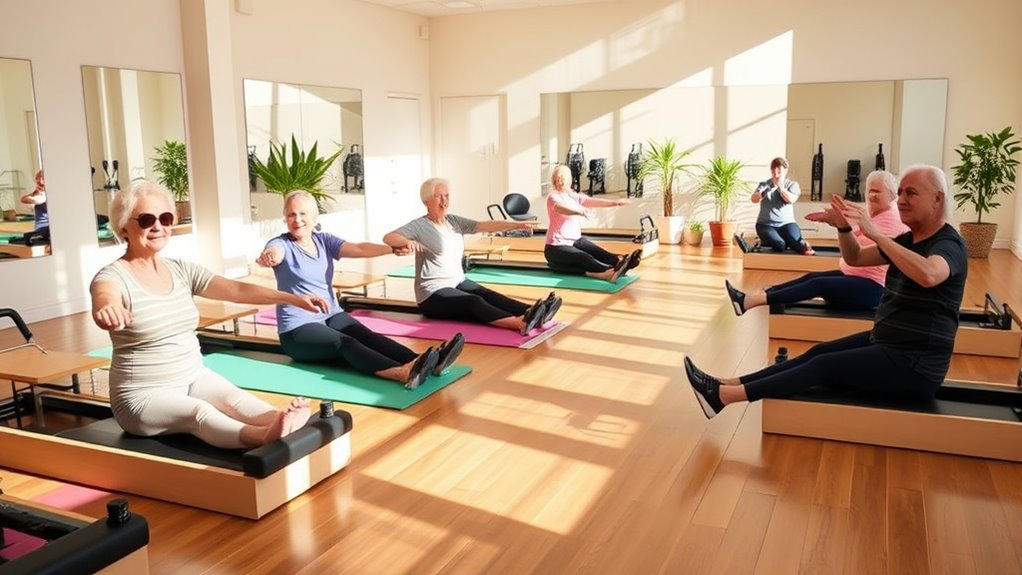
Before you immerse yourself in your Pilates session, it’s essential to create a supportive environment that enhances your experience.
Start by laying out a comfortable mat or soft rug to support your body during floor exercises. Choose a quiet space where you can lie down comfortably, free from distractions.
Dress in breathable clothing that allows for a full range of motion, making sure you can move freely as you engage your core. Incorporate deep breathing at the beginning, which won’t only relax you but also help activate your muscles for the workout ahead. Additionally, maintaining good indoor air quality can contribute to better overall well-being during your practice. Ensuring energy efficiency in your home can also support a more comfortable workout environment. Keeping the temperature regulated in your space can enhance your workout comfort. Regularly using an air purifier can help maintain optimal air quality that supports better focus and performance during your session.
Finally, keep a water bottle nearby to stay hydrated, especially if you plan to practice regularly or participate in multiple sessions. Additionally, consider using a portable camping toilet to ensure comfort during longer practices without interruptions.
Essential Warm-Up Techniques
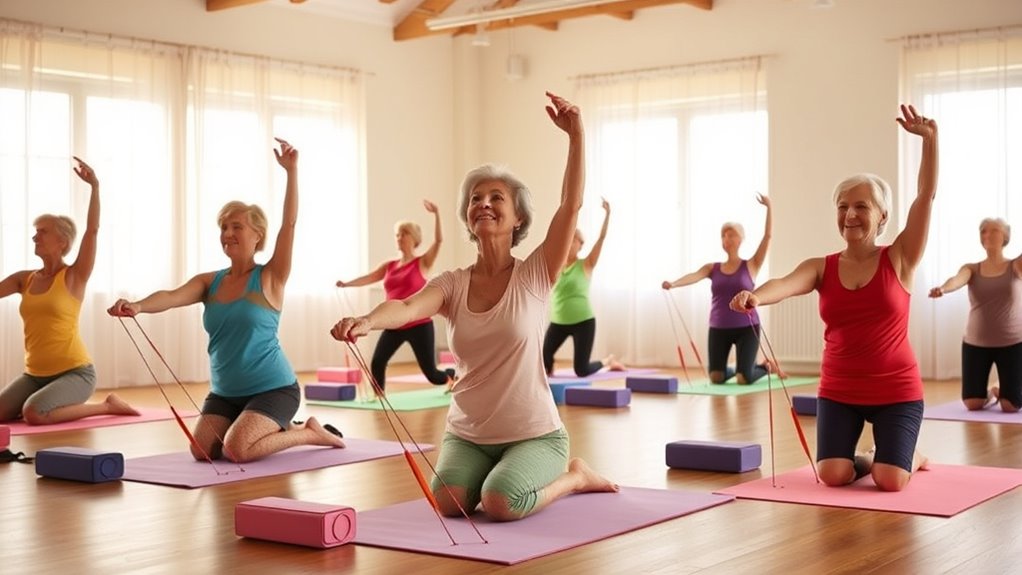
Five essential warm-up techniques can set the stage for an effective Pilates session.
Start by lying on your side with hips stacked and knees bent at a 90-degree angle. Here are key warm-up moves to incorporate:
- Spinal twist: Gently rotate your torso while inhaling and exhaling to open your chest and shoulders.
- Deep breathing: Focus on inhaling deeply and exhaling fully to enhance relaxation and core engagement, as this aligns with mental wellbeing principles. Incorporating energy-saving features during your workout can also lead to greater efficiency and effectiveness. Additionally, understanding financial considerations for ongoing fitness programs can help seniors maintain their exercise routines. Engaging in mindfulness practices before your session can further enhance your focus and connection to your body.
- Lower back press: Press your lower back into the floor during movements to maintain proper alignment.
- Gradual changes: Move smoothly from one exercise to another, increasing blood flow and flexibility in your core and pelvic regions.
These techniques help prepare your body, ensuring you’re ready for a successful Pilates workout. Additionally, incorporating proper hydration can further enhance your performance and recovery during exercise.
Core Engagement and Exercise Overview
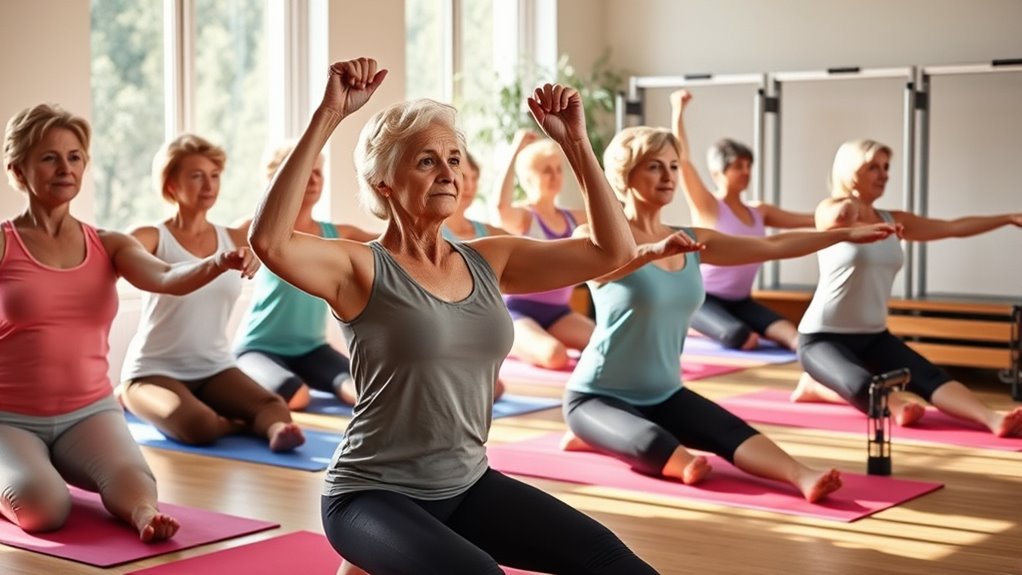
Core engagement is essential in every Pilates session, helping you stabilize your body and maintain proper alignment.
You’ll learn to pull your belly button into your spine, guaranteeing your core muscles are active during movements. Exercises like leg lifts and pelvic tilts are perfect for strengthening your core while supporting balance and mobility. Regular physical activity is critical for maintaining a healthy weight and preventing behavioral issues. Additionally, engaging in mindfulness practices can enhance your focus and connection to your body during workouts. Studies have shown that emotional well-being positively impacts physical health, making mindfulness a valuable tool in your fitness journey. The importance of core strength is also recognized in various fitness disciplines, emphasizing its role in overall physical health.
Engaging your core by pulling your belly button into your spine enhances balance and mobility through effective exercises like leg lifts and pelvic tilts.
As you perform these movements, focus on staying lifted and keeping your body nice and straight. Variations such as the dead bug exercise and ballet plié allow you to adjust intensity based on your capabilities without losing core engagement.
Incorporating high nutrient foods into your breakfast routine can further enhance your overall health and energy levels.
Smooth shifts between exercises help you consistently activate your core muscles, building endurance and strength. Engaging in brain-boosting activities can also contribute to your overall mental well-being during your fitness journey.
Targeted Glute and Pelvic Exercises
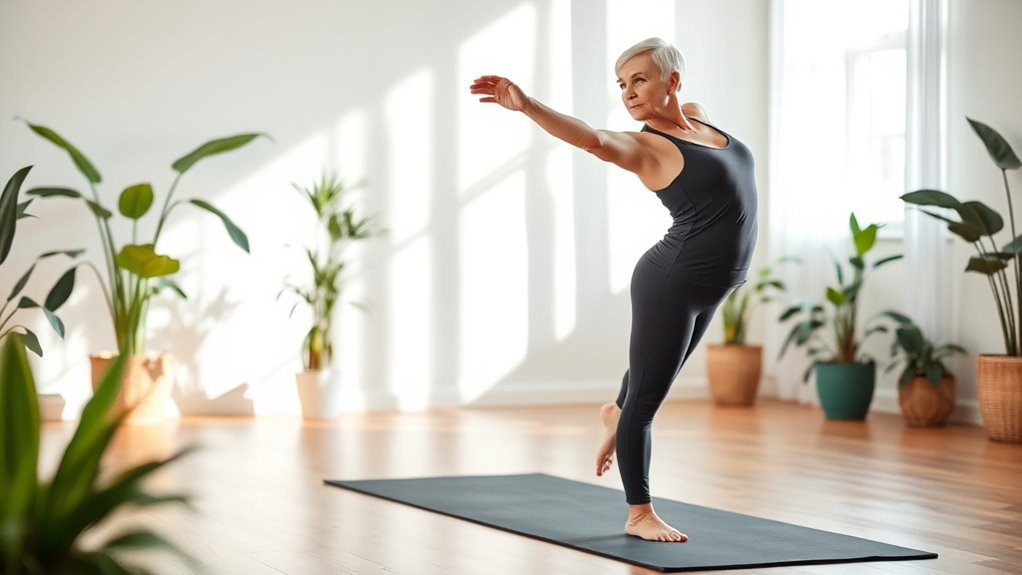
When you focus on targeted glute and pelvic exercises, you can greatly enhance your core strength and stability. Techniques like glute activation and pelvic floor engagement are essential for maintaining mobility and reducing lower back discomfort. Additionally, understanding the principle of comparative advantage can help you prioritize your exercises effectively. Incorporating basic carpentry skills into your routine can also promote better posture and alignment during workouts. Embracing minimalist principles in your approach can further streamline your Pilates practice, allowing you to focus on the essentials and achieve greater results. Establishing consistent routines in your exercise regimen can also provide emotional security, leading to improved outcomes. Let’s explore how these exercises can benefit you in your Pilates routine.
Glute Activation Techniques
Glute activation techniques are essential for seniors looking to boost mobility and strength. By focusing on targeted exercises, you can effectively engage your glutes while maintaining core stability.
Here are some effective techniques to incorporate into your routine:
- Pelvic tilts to strengthen the pelvic floor and glutes
- Glute bridges to activate gluteal muscles without strain
- Ballet plié movements for enhanced mobility and engagement
- Modified exercises, like dropping heels during glute lifts, to accommodate all fitness levels
Consistent practice of these techniques can help alleviate lower back discomfort, improve stability, and enhance overall strength.
Pelvic Floor Engagement
Engaging the pelvic floor is essential for enhancing stability and strength in your glutes and core, especially as you age. By incorporating exercises like glute bridges and pelvic tilts, you activate both your glutes and pelvic floor, improving control and strength.
As you perform leg lifts or ballet pliés, maintaining core strength guarantees those pelvic floor muscles stay engaged. Remember, proper alignment is key; it helps maximize the effectiveness of your workout.
You can also introduce pulsing movements with your feet on tippy toes to further stimulate your pelvic floor and glutes, boosting muscle awareness and coordination. Focusing on deep breathing techniques during these exercises will enhance pelvic floor engagement, making your workouts more effective.
Stretching for Flexibility and Recovery

Stretching after your Pilates session is essential for relaxing your muscles and enhancing flexibility.
By incorporating effective recovery techniques like the cat-cow stretch and torso twists, you can greatly improve your mobility and reduce the risk of injury.
Let’s explore how these simple stretches can make a big difference in your overall well-being.
Importance of Stretching
When you prioritize post-exercise stretching, you not only relax your muscles but also enhance your flexibility and prevent stiffness. This is essential for maintaining mobility and avoiding injuries as you age.
Here’s why stretching should be a key part of your routine:
- Improves spinal flexibility and alleviates lower back tension.
- Increases blood flow to muscles, promoting recovery and reducing soreness.
- Enhances balance and coordination, important for fall prevention.
- Can be modified to suit your individual capabilities, ensuring safety and effectiveness.
Effective Recovery Techniques
To maximize your recovery after Pilates, incorporating effective stretching techniques is essential. Effective stretches like the cat-cow stretch and child’s pose help relax your muscles, promote flexibility, and support recovery.
These stretches alleviate tension in your lower back, enhancing mobility and maintaining your independence.
Consider adding the pretzel position and torso twists, which target your hip and spinal regions, further improving flexibility.
Don’t hesitate to modify stretches, like adjusting the depth of your child’s pose, so you feel comfortable while still benefiting from the routine.
Modifications for All Fitness Levels
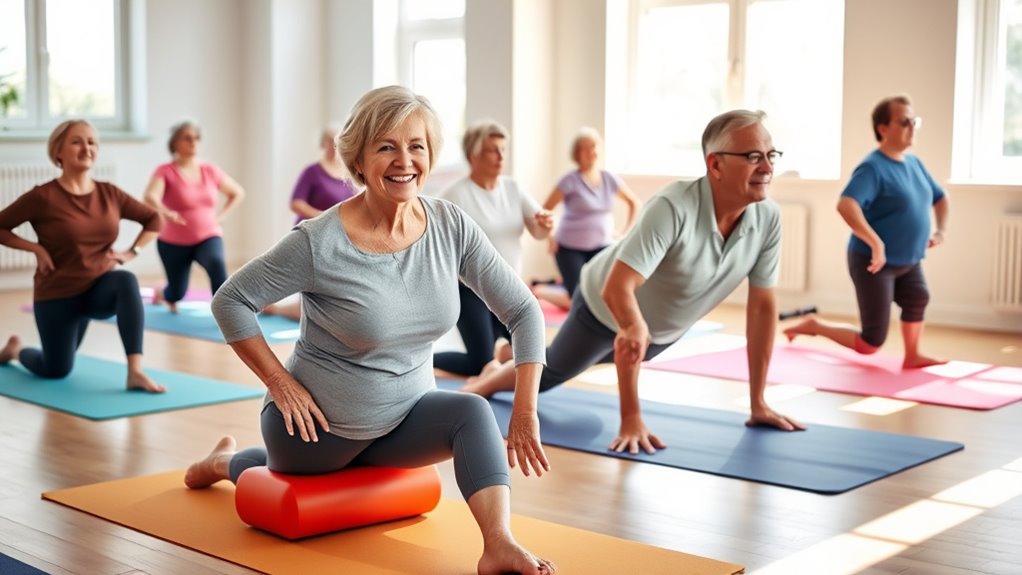
Modifications are essential for ensuring that seniors can safely engage in Pilates, regardless of their fitness levels. You can adapt exercises to suit your needs, making your practice both effective and enjoyable.
Modifications are crucial for seniors to safely and enjoyably practice Pilates, accommodating various fitness levels.
Here are some helpful modifications to take into account:
- Start with simpler variations, like glute lifts, by dropping your heels for reduced intensity.
- If you have a limited range of motion, opt for alternative movements that match your comfort level.
- Incorporate deep breathing techniques to enhance muscle engagement and maintain proper alignment.
- Use gentle stretches, like the cat-cow stretch and child’s pose, to improve flexibility and relaxation.
These modifications allow you to build strength at your own pace while enjoying the benefits of Pilates.
Creating a Supportive Workout Environment
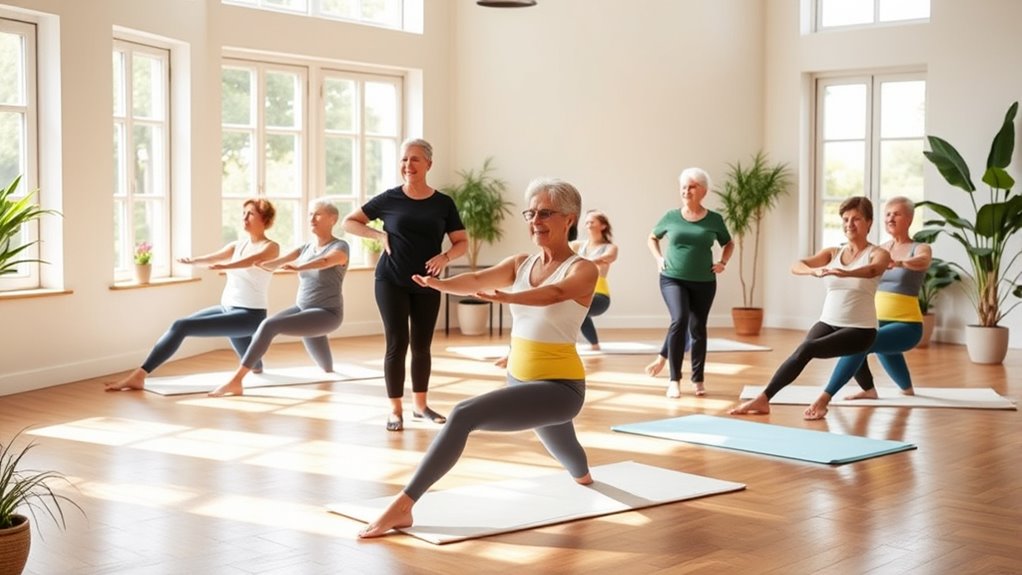
Creating a supportive workout environment can greatly enhance your Pilates experience, especially for seniors. To guarantee comfort and safety, provide adequate space and use soft mats or rugs. Proper lighting helps you see your form, maintaining alignment during exercises. Incorporating props like cushions and resistance bands increases accessibility for those with limited mobility.
| Element | Importance |
|---|---|
| Adequate Space | Allows smooth shifts and safety |
| Props | Offers modifications and support |
| Calm Environment | Promotes relaxation and focus |
A calm and quiet environment, possibly with soft background music, creates an inviting atmosphere. By prioritizing these elements, you’ll foster an enjoyable and effective Pilates practice tailored for seniors.
Encouraging Community and Continued Participation

When seniors come together for Pilates sessions, the sense of community can greatly boost motivation and enjoyment. Engaging with others fosters friendships and keeps you accountable, encouraging regular participation.
Here are some ways community engagement enhances your Pilates experience:
- Supportive Environment: Share your journey with peers, making workouts more enjoyable.
- Shared Goals: Work together towards improved physical wellness, creating connections.
- Increased Accountability: Commit to your fitness goals, knowing others are counting on you.
- Consistent Attendance: Regular classes lead to better core strength and flexibility, essential for mobility.
Frequently Asked Questions
How to Strengthen Your Core as a Senior?
To strengthen your core as a senior, focus on exercises that promote stability and flexibility.
Try leg lifts while keeping your alignment to engage your abdominal muscles. Incorporate glute bridges and pelvic tilts to bolster your pelvic floor and glutes.
Don’t forget to utilize deep breathing techniques during your workouts; they enhance oxygen flow and relaxation.
Regularly practicing these movements will improve your overall physical wellness and mobility as you age.
How Long Does Pilates Take to Strengthen the Core?
Imagine yourself gliding through movements like a dancer, feeling your core come alive.
It typically takes about 4 to 8 weeks of consistent Pilates practice, at least 2 to 3 times a week, to notice significant improvements in your core strength.
Within 12 weeks, you could see a remarkable increase in core stability and endurance, enhancing your overall posture and daily performance.
Is 70 Too Old to Start Pilates?
No, 70 isn’t too old to start Pilates!
In fact, many people your age begin this low-impact exercise and experience fantastic benefits. You’ll find it helps improve your balance, flexibility, and overall strength without stressing your joints.
Plus, the exercises can be easily modified to fit your needs. Just listen to your body, and start at your own pace. You might be surprised at how much better you feel!
Is 20 Minutes of Pilates a Day Enough?
Imagine feeling stronger, more flexible, and in control of your body.
Is 20 minutes of Pilates a day enough? Absolutely! That short, focused session can work wonders for your core strength and mobility.
Even if you’re just starting out, those twenty minutes are manageable and effective. Regular practice can lead to noticeable improvements in your posture and overall well-being.
Conclusion
As you commence your Pilates journey, remember that strengthening your core is like planting seeds in a garden—you’ll see the fruits of your labor bloom over time. Embrace the benefits of each session, and don’t shy away from modifications that suit your needs. With a supportive environment and a community cheering you on, you’ll not only enhance your strength and flexibility but also cultivate a lasting love for movement. Keep going—you’re doing great!

